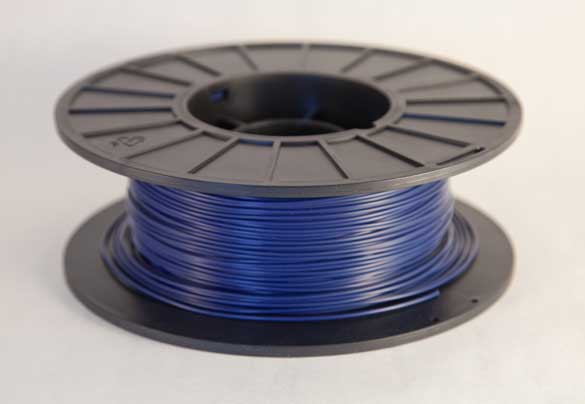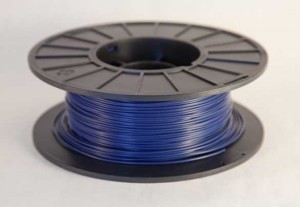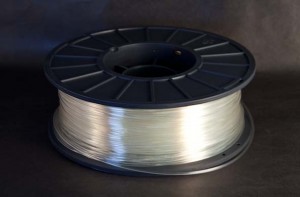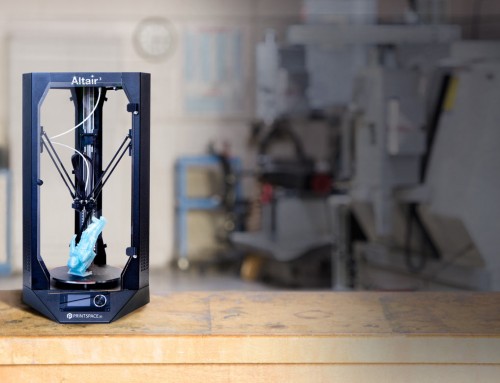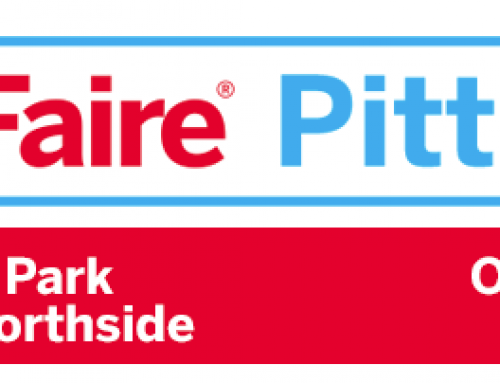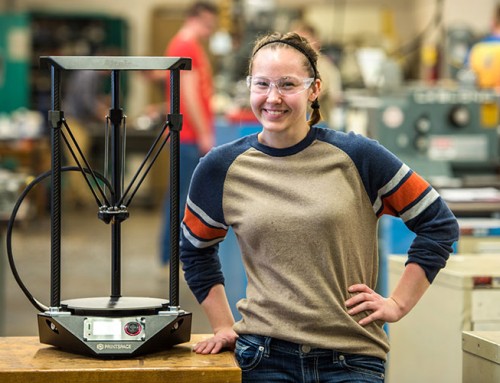Common 3D Printing Materials
There are many types of materials being explored in the world of 3D printing, but we will focus on the most common materials used with consumer 3D printers. In order to create a 3D printed object, you need to choose a printing material, generally in the form of a filament. Keep in mind that some printers only use certain types of materials.
The three materials we are analyzing: PLA, ABS, and Nylon are all thermoplastics. What this means for 3D printing is that these materials become moldable and soft on heating and change into solid form when cooled. This attribute has made these materials highly demanded in the market.
How Do the Materials Compare?
ABS
ABS is made out of petroleum and is a strong material. It is durable, difficult to break and is more resistant to heat than PLA. After printing, ABS has a nice smooth finish that can be easily sanded, painted, machined, or glued if necessary. ABS will also dissolve in acetone. This is a nice feature for cleaning excess material off of a print nozzle. A drop or two will even weld pieces of ABS together, or polish the finish.
Like all materials, ABS does have some disadvantages. It needs to be used with a heated print bed to keep a somewhat consistent temperature in order to prevent warping or cracking. Curling upwards is also a problem and while there are ways to improve this, parts printed that should have square corners often tend to be somewhat rounded. Printed ABS parts placed under tension are also prone to de-lamination. Another negative is that ABS gives off fumes while printing. These fumes can be toxic so a well ventilated area or fume hood is recommended.
Spool of ABS
PLA
PLA is newer to 3D printing then ABS and people like it because it’s biodegradable. Made from renewable resources like corn, potatoes, and sugarcane, it is an environmentally friendly material. PLA is easier to print large parts with, and requires less force to extrude allowing it to print at higher speeds then ABS. While extruding, PLA gives off a slight maple sugar scent. It is not prone to warping and shrinking like ABS is, but PLA printed products shouldn’t be used in places where it will be exposed to heat due to a lower melting temperature. Even the inside of a car on a hot day can cause deformation.
Spool of PLA
Nylon
Nylon is newer to 3D printing then both ABS and PLA. It is not often used, but has some very unique benefits. Nylon has high self-bonding properties that prevent the layers from de-laminating when put under tension. It doesn’t have warping issues so no heated print bed or cooling fans are needed. A fun reason to choose Nylon is the ability to create any color you want since it is very easy to dye. You can even create tie-dye strands of nylon! It’s a little more difficult to print with as compared to PLA and ABS but it is immensely flexible compared to all other materials. A cheap way to try nylon is to use some weed wacker line.
The main negative for nylon is that it is very susceptible to water. It will need to be dried before printing if it has been exposed to humidity. Nylon also requires a higher print temperature and not all extruders are capable of reaching a high enough temperature to extrude. It can have issues sticking to a print bed so printing on masonite or hardboard is a good solution.
Check out how to tie dye nylon by Rich Rap
Preferred Uses for Each Material
Engineers and professional 3D printing applications often prefer ABS because of its strength, higher temperature tolerance, and ability to be machined. ABS is a good choice for structural parts and for parts that operate in higher temperature environments.
Industrial engineers, artists, or hobbyists might prefer PLA because of the wide range of colors and translucencies available. PLA is easier to print with and easier to create larger with due to limited warping. PLA is a good choice for printers without a heated print bed, those that need sharp edges on products, or for people interested in color variants.
For products that will have moving parts, Nylon is a good choice because its self-lubrication properties make it a low friction material.
All three materials work best if they are stored in air-tight, sealed containers. Moisture absorption in these materials will cause them to react differently while printing. All three materials also come in granule forms. People using their own extruders, or lyman extruders like the filabot will be interested in these granule forms.
Side by Side Chart Comparison
| PLA | ABS | Nylon | |
| Scientific Designation | Polylactic acid or polylactide | Acrylonitrile butadiene styrene | Aliphatic Polyamide Blend |
| Melting Temp | 160-220˚C | 215-250˚C | 240-250˚C |
| Properties | Strong Brittle |
Stronger Durable Slightly flexible Heat resistant |
Strongest Flexible Heat resistant |
| Advantages | • No heated printbed needed • Limited warping and shrinking • No hazardous fumes and environmentally friendly • Smells like maple syrup when heated • Hard and soft variants • Many colors available. |
• Smooth finish • Difficult to break • Many colors available |
• Chemical resistant. • Inexpensive • Wear resistant • Can use dye to add color • Self lubricating properties • Self bonding properties • Most grades do not emit fumes • Can use weedwacker nylon cord • Cooling fans not required • Heated bed not necessary |
| Disadvantages | • Brittle • Slow cooling • Hard to chemically disolve material (cleaning out nozzle) • Low heat resistance, need to use a second cooling fan to cool the part while printing |
• Unpleasant odor. Use in a well ventilated area • Need heated printbed • Suffers from warping • Can be overcome with a heated bed or enclosure |
• Can be stringy • Warping issues. Print on cardboard or Garolite LE to prevent warping. • Need to dry nylon before printing if it has been exposed to humidity. • Issues sticking to bed. Use fiberboard to print on. |
| Finishing | Sanding possible Paint with Acrylic Limited glueing |
Easy sanding Easy glueing Easily dissolvable in acetone |
Smooth Shiny Able to paint |
| Best Uses | Small Parts | Mechanical Parts | Best used for low friction parts. |
| Price for Filament | $44/kg ($20/lb) hard $66/kg ($30/lb) soft | $44/kg ($20/lb) | 275ft weed wacker trimmer line for $7.98 $44/kg ($20/lb) (Taulman 618) or $66/kg ($30/lb) (Taulman 645) |
